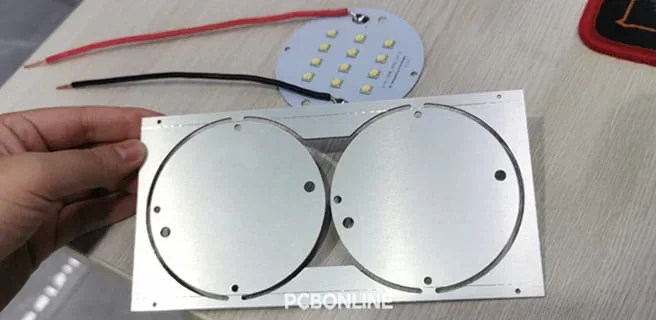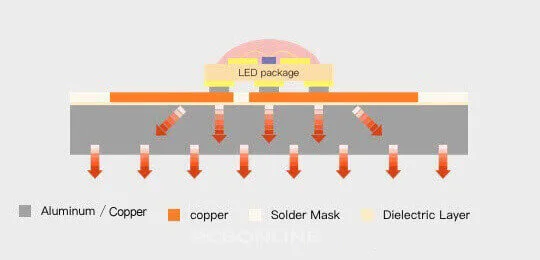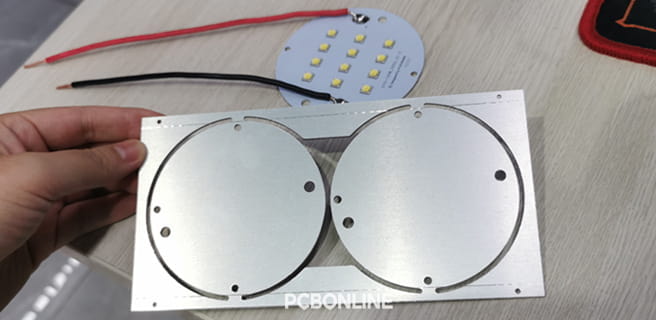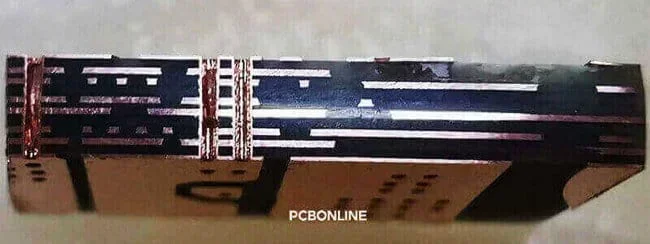![]()
MCPCBs or metal core PCBs are widely used for LEDs and thermal dissipation applications.
The one-stop PCB manufacturer PCBONLINE reveals MCPCBs and a comparison between aluminum and copper metal circuit boards and other PCBs for your reference.
Part 1. What is MCPCB
MCPCB or metal core PCB is a printed circuit board that uses copper or aluminum as its substrate material.
An MCPCB consists of a metal core, prepreg/polymer layers, copper circuit layers, and solder masks.
The metal core of MCPCB is usually aluminum or copper. Iron rarely is used for MCPCBs.
Aluminum PCB is the most common and affordable MCPCB for LEDs. It has 1 to 4 circuit layers.

Copper-base PCB is an MCPCB better than aluminum PCB in thermal dissipation. It has 1 to 8 circuit layers.
From a metal core PCB manufacturer PCBONLINE, you can also have MCPCBs that use hybrid or inlay materials manufactured, such as copper/FR4, copper/ceramic, aluminum/FR4, etc.
Advantages of MCPCB
MCPCB was invented to replace the FR4 PCB for LEDs because metal conducts heat a lot faster than FR4.
Thermal dissipation is the core advantage of MCPCBs. The thermal conductivity of regular MCPCBs is 1W/mK to 9W/mK. While an FR4 PCB has a thermal conductivity of only 0.3W/mK.
Regular MCPCB Has 1 to 2 Layers
For normal MCPCBs, thermal conducts from electronic components to the copper layer, prepreg layer, and metal substrate.

We all know that copper and aluminum conduct heat quickly, but the prepreg material conducts thermal much slower. So the prepreg material determines the thermal conductivity of MCPCBs.
The MCPCB manufacturer PCBONLINE uses the same prepreg material for aluminum and copper MCPCBs. It is a special polymer filled with epoxy resin composed of aluminum oxide and silicon powder. Though its thermal conductivity is better than FR4, it is much poorer than metal.
For this, if a regular MCPCB has multiple PCB layers, the heat conductivity effect will be not very good. So regular MCPCBs usually are designed to have only 1 or 2 PCB layers.
However, for copper MCPCBs, the thermoelectric separation technology provides more possibilities. However, the thermal conductivity of copper MCPCBs from PCBONLINE can reach 398W/mK.
Part 2. Copper MCPCB vs Aluminum PCB
Copper-base PCBs and aluminum PCBs are both widely used MCPCBs for thermal dissipation devices. Which is the best MCPCB option for your design? Please check copper MCPCBs and aluminum PCBs.
Copper MCPCBs
![]()
Coppper-based MCPCB is also known as copper-core PCB.
Regular copper base MCPCB is a 1 or 2-layer metal core PCB. Its thermal conductivity is better than an aluminum PCB in the same stack-up.
However, normal copper base PCBs don't have many advantages over single-sided 1- or 2-layer aluminum PCBs because their price is higher.
However, it becomes another story when you design thermoelectric separation copper MCPCBs.
Thermoelectric separation copper MCPCBs can have up to 8 PCB layers. And the thermal conductivity is the same as copper!
![]()
Thermoelectric separation means the circuity and thermal conductivity are separated. The copper traces conduct electricity, and the prepreg only isolates adjacent copper layers. Thermal conducts directly through the copper vias under the components to the copper substrate. Around the copper vias, the resin is filled to isolate the copper vias and the circuit layers.
If you can design the thermoelectric separation copper MCPCB, you don't need to worry about thermal management anymore.
PCBONLINE will fabricate copper MCPCBs using thermoelectric separation technology. Besides, 1 to 8-layer MCPCB, inlaid copper MCPCB, and hybrid-laminated MCPCB are available. If you have problems or don't have a design, PCBONLINE can also provide you with PCB design services.
Aluminum PCBs

An aluminum core PCB can be single-layered, 2-layer with a single component-mounting side, 2-layer with double component-mounting sides, or 4-layer with double component-mounting sides.
The thermal conductivity of aluminum is lower than copper, so compared with single-sided 1 or 2-layer copper base PCBs, single-sided aluminum PCBs conduct thermal a little slower.
However, the aluminum PCB price is much lower than copper MCPCBs. From PCBONLINE, you can order bulky aluminum PCBs for only $30/㎡.
For LED lamps, the aluminum PCB is the most cost-effective PCB option.
Copper MCPCBs vs aluminum PCBs
For MCPCBs, there are 1, 2, and 4-layer aluminum core PCBs, while there are 1, 2, 4, 6, and 8-layer copper core PCBs.
The thermal conductivity of regular copper MCPCBs is a little better than aluminum PCBs, and the thermal expansion of copper base PCBs is smaller than aluminum PCBs, but the price is higher.
Copper MCPCBs are only single-sided, but aluminum PCBs can be single-sided or double-sided.
However, copper MCPCBs can be designed and fabricated to be thermoelectrically separated. In such cases, the thermal conductivity of copper MCPCBs can reach 398W/mK.
Part 3. MCPCB vs Ceramic PCB vs FR4 PCB
Is MCPCB, FR4 PCB, or ceramic PCB the best for a thermal management project?
MCPCBs are a common PCB choice for devices such as LEDs that require thermal management, but ceramic PCBs may be more effective. Sometimes, FR4 PCBs can also serve thermal dissipation purposes if they are artfully designed.
Please check a comparison among MCPCBs, ceramic PCBs, and FR4 PCBs below.
|
|
MCPCB
|
Ceramic PCB
|
FR4 PCB
|
|
PCB layer number
|
Regular copper MCPCB: 1 or 2 Thermoelectric separated copper MCPCB: 1 to 8 Aluminum PCB: 1 to 4 |
1 or 2
|
No limit, but for thermal management, the PCB layer number is smaller the better
|
|
Thermal conductivity
|
Regular MCPCB: 1W/mK to 9W/mK Thermoelectric separated copper MCPCB: 400W/mK |
Aluminum nitride PCB: 180W/mK Alumina PCB: 20W/mK |
About 0.3W/mK
|
|
Components mounting side
|
Copper MCPCB: single-sided Aluminum PCB: single or double-sided |
Single-sided
|
Single or double-sided
|
|
Thermal expansion coefficient
|
Large; the CTE of copper MCPCB is smaller than aluminum PCB
|
Small and close to semiconductor (IC)
|
Largest
|
|
Fabrication cost
|
Copper MCPCB price is higher than aluminum PCB MCPCB price is lower than ceramic PCB |
Highest
|
Depending on the fabrication complexity
|
Besides the above PCBs, PCBs with phase-change substrate materials can also be a choice for thermal dissipation solutions. For example, the below hybrid MCPCB used for an air condition system has a copper and FR4 phase-change substrate.
![]()
MCPCBs provide reliable and cost-effective options for thermal management. Besides MCPCBs, ceramic PCBs may be a better option for high-power devices, especially when the PCB has ICs.
To choose the best PCB for your project, you need to make a good balance between thermal conductivity, thermal expansion, and budget. But whatever the PCB substrate and requirements of your design are, PCBONLINE can meet your fabrication requirements.
Part 4. Metal Core PCB Manufacturer PCBONLINE
The MCPCB manufacturer PCBONLINE provides one-stop thermal management solutions for power devices.
PCBONLINE fabricates and assembles regular copper MCPCBs, thermoelectric separated PCBs, aluminum PCBs, and phase-change-substrate MCPCBs.
If you don't have a PCB design, the professional engineers from PCBONLINE can design for your project. Besides, PCBONLINE provides value-added services, such as conformal coating, IC programming, mechanical boxes, and box-build assembly for MCPCB assemblies.

Here are reasons why you choose to work with PCBONLINE for MCPCB fabrication:
- For regular MCPCBs, PCBONLINE can customize the thermal conductivity within the 1W/mK to 9W/mK range.
- Grasps core technology of thermoelectric separation for copper MCPCBs. Can make up to 8 copper layers.
- For aluminum PCBs, PCBONLINE already achieved fully automatic fabrication and reduced the aluminum PCB price to $30/㎡ for bulky production.
- MCPCBs with phase-change substrate materials are also available, such as copper and FR4 substrate PCB, copper, and ceramic substrate PCB, etc.
- Provides free professional one-on-one engineering support throughout your project.
- Besides MCPCBs, PCBONLINE provides ceramic PCBs, glass PCBs, and FR4 PCBs for LEDs and high-power devices.
If you have an MCPCB project that needs one-stop fabrication, please feel free to contact PCBONLINE by email at info@pcbonline.com.
Part 5: Examples of MCPCBs for LEDs and Thermal Management
PCBONLINE has rich experiences in providing thermal management MCPCB solutions for our clients around the globe, from PCB design, fabrication, and assembly, to end product delivery.
Example 1 - thermoelectric separation copper MCPCB

This is an 8-layer thermoelectric separation copper base PCB. The copper thickness of the inner and outer layers is 12oz. From the cross-section, you can see very even electroplated via copper and layer copper. Our PCB lamination has perfect quality.
Example 2 - aluminum LED metal core PCB
![]()
This is a 100W LED metal core PCB designed, fabricated, and assembled by PCBONLINE, including the LED beads. The MCPCB is an aluminum-backed PCB in a rounded shape. The MCPCB assembly has 16 LED beads, and each bead has 4 LED chips.
Example 3 - FR4 and copper hybrid MCPCB

This is a copper-inlay FR4 PCB used for high-power electric car charging stations. It is the adaptor board. In this hybrid MCPCB, the 3oz circuit layers are responsible for small currents and signal conduct, while the copper plates with screws are responsible for large currents and dissipation.
The effective combination between the copper plates and FR4 is critical to the success of this MCPCB. PCBONLINE has strong PCB manufacturing capabilities and technical experience in electronic vehicle electronics.
Conclusion
MCPCBs are a cost-effective PCB option for devices that require good thermal dissipation. Copper MCPCBs have faster thermal conductivity and more minor thermal expansion than aluminum PCBs, but the price is higher. Besides MCPCBs, you can also consider ceramic PCBs and FR4 PCBs. If you need the design and fabrication of thermal management projects, don't miss the 24-year-old source factory PCBONLINE.
Related Content:




